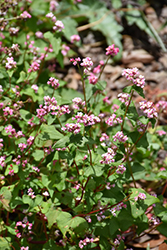Fri & Sat 8am - 8pm
Sun 8am - 7pm
Anytown, USA 12345
fax: 261.787.0463
e-mail: info@successgc.com


Plant Finder

Takane Ruby Buckwheat
Fagopyrum esculentum 'Takane Ruby'
Height: 3 feet
Spacing: 8 inches
Sunlight:
![]()
Hardiness Zone: (annual)
Description:
A stunning selection perfect for adding interest and color to gardens and containers; long-lasting ruby-pink blooms rise above green, heart shaped leaves on red stems; seeds can be harvested and turned into flour; great for pollinators making honey
Ornamental Features
Takane Ruby Buckwheat features showy clusters of rose flowers with ruby-red overtones rising above the foliage from early summer to late fall. The flowers are excellent for cutting. Its small heart-shaped leaves remain green in color throughout the season. The red stems can be quite attractive.
This plant is primarily grown as an ornamental, but it's also valued for its edible qualities. The small mild seeds are most often used in the following ways:
- Cooking
- Preserves
Landscape Attributes
Takane Ruby Buckwheat is an herbaceous annual with an upright spreading habit of growth. Its medium texture blends into the garden, but can always be balanced by a couple of finer or coarser plants for an effective composition.
This is a relatively low maintenance plant, and should only be pruned after flowering to avoid removing any of the current season's flowers. It is a good choice for attracting birds, bees and butterflies to your yard. Gardeners should be aware of the following characteristic(s) that may warrant special consideration;
- Self-Seeding
Takane Ruby Buckwheat is recommended for the following landscape applications;
- Mass Planting
- Rock/Alpine Gardens
- General Garden Use
- Groundcover
- Naturalizing And Woodland Gardens
- Container Planting
Planting & Growing
Takane Ruby Buckwheat will grow to be about 3 feet tall at maturity, with a spread of 4 feet. When planted in rows, individual plants should be spaced approximately 8 inches apart. This vegetable plant is an annual, which means that it will grow for one season in your garden and then die after producing a crop. As this plant tends to go dormant in summer, it is best interplanted with late-season bloomers to hide the dying foliage.
This plant should only be grown in full sunlight. It prefers dry to average moisture levels with very well-drained soil, and will often die in standing water. It is considered to be drought-tolerant, and thus makes an ideal choice for a low-water garden or xeriscape application. This plant should not require much in the way of fertilizing once established, although it may appreciate a shot of general-purpose fertilizer from time to time early in the growing season. It is not particular as to soil pH, but grows best in poor soils, and is able to handle environmental salt. It is highly tolerant of urban pollution and will even thrive in inner city environments. This is a selected variety of a species not originally from North America.; however, as a cultivated variety, be aware that it may be subject to certain restrictions or prohibitions on propagation.
Takane Ruby Buckwheat is a fine choice for the garden, but it is also a good selection for planting in outdoor pots and containers. With its upright habit of growth, it is best suited for use as a 'thriller' in the 'spiller-thriller-filler' container combination; plant it near the center of the pot, surrounded by smaller plants and those that spill over the edges. It is even sizeable enough that it can be grown alone in a suitable container. Note that when growing plants in outdoor containers and baskets, they may require more frequent waterings than they would in the yard or garden.
